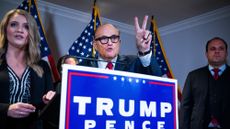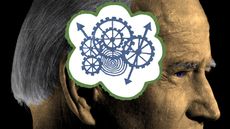The battle over 'chain migration'
President Trump wants to limit family-based immigration as part of an overall reform of the system. Why?

President Trump wants to limit family-based immigration as part of an overall reform of the system. Why? Here's everything you need to know:
What is 'chain migration'?
The term itself remains a point of heated contention. Formally known as "family reunification," it's the process by which U.S. citizens and green-card holders can sponsor their relatives to come and live here, too. In 2016, 805,000 of the 1.1 million people who legally entered the U.S. came in via a family member — with Mexico, the Philippines, and China leading the list of feeder countries. For advocates, family-based immigration has been a cornerstone of the U.S. entry system for decades, and part and parcel of the American Dream. President Trump and other immigration restrictionists contend that "chain migration" — as they prefer to call it — is responsible for a flood of distant relations and dependents entering the country, regardless of their qualifications. "Chain migration is a total disaster," said Trump in January, calling for a move to a merit-based system. "It threatens our security and our economy, and provides a gateway for terrorism."
Subscribe to The Week
Escape your echo chamber. Get the facts behind the news, plus analysis from multiple perspectives.

Sign up for The Week's Free Newsletters
From our morning news briefing to a weekly Good News Newsletter, get the best of The Week delivered directly to your inbox.
From our morning news briefing to a weekly Good News Newsletter, get the best of The Week delivered directly to your inbox.
Which relatives can come in?
Trump has contended that "a single immigrant can bring in virtually unlimited numbers of distant relatives." But that's not really true. Under the 1965 Immigration Act, immigrants who have gone through the five-year process of becoming a U.S. citizen can petition for spouses, parents, siblings, and children to join them, while green-card holders can sponsor only spouses and unmarried children. Cousins, uncles, aunts, and grandparents can't be sponsored. In addition, sponsorships of people who aren't parents, children, or spouses are subject to strict numerical caps, including a limit of 25,620 per country each year — which is why Mexicans and Filipinos now have an average wait of about 25 years for a visa. For many other countries, the wait is longer than 10 years. Under the current system, says immigration attorney David Leopold, "it's easier for that person to go get a degree in higher education and come in on an employment-based visa." Applicants also have to pass various standards for entry.
What are the standards?
Sponsors have to prove that their annual household income is 125 percent of the poverty line — at least $20,300 for a two-person household — and show that they can support their family member without government aid. Every visa applicant also has to go through a criminal and terrorism background check. Trump has repeatedly connected chain migration to two terrorist attacks last year, both in New York City. The first, a truck attack on a Manhattan bike path, was carried out by Sayfullo Saipov, who actually came over from Uzbekistan via the diversity visa program. The second suspect, attempted subway bomber Akayed Ullah, moved over from Bangladesh via a family member. Authorities say both Saipov and Ullah passed all the necessary security checks and were radicalized after they got here. Since 1975, a total of 16 people have been murdered in attacks on U.S. soil by terrorists who entered on a family-based green card, according to a study by the Cato Institute's Alex Nowrasteh. During that time, 35 million people came into the country through green cards.
What about the benefits?
Advocates say that America was built on family-based immigration, with previous waves of Italian, Irish, German, Jewish, Polish, and other immigrants bringing over family members once they got a foothold in America. Those relatives helped them settle in their communities, start family businesses, and contribute to the national economy. Today, many take low-paid jobs in the food, service, and health-care industries, but nearly half of diversity-visa and family-based immigrants hold college or graduate degrees, making them better educated than the average U.S.-born American. The president himself wouldn't be here without family migration. Trump's paternal grandfather, Friedrich Trump, immigrated to New York in 1885 to join his oldest sister; the president's mother followed her sister from Scotland in 1930. "Donald Trump is a product of 'chain migration,'" says Columbia University historian Mae M. Ngai. Trump's wife, Melania, is an immigrant from Slovenia whose parents followed her to the U.S.
What do critics say?
Restrictionists say the situation has gotten out of hand. The foreign-born population of the U.S. has quadrupled since 1970; immigrants who arrived from 1981 to 2000 sponsored an average of 1.77 relatives to join them, but the most recent are sponsoring an average of 3.46, according to the Center for Immigration Studies (CIS). The current system "takes away the immigration decision from policymakers and privatizes it to the individuals that yesterday were immigrants," says Mark Krikorian, executive director of CIS, which favors strict limits on immigration.
What has Trump proposed?
As part of a broader package that includes a border wall and a path to citizenship for 1.8 million "DREAMers," or children who were illegally brought to the U.S., Trump wants to limit sponsorship to the "nuclear family" — that is, to spouses and children under 21 only. But even if Congress did pass much tighter restrictions on families, authorities would still have to process the nearly 4 million people already on the waiting list. That would take more than a decade, says Ira Mehlman, media director for the conservative Federation for American Immigration Reform — and Democrats "will use every minute of those 10 years to get those immigrants back, piece by piece."
What's in a name?
"Amnesty." "DREAMers." "Anchor baby." The immigration debate has become a war of words, as both sides seek to frame the issues with terms that shape perceptions and drive popular opinion. Trump has successfully weaponized "chain migration," which in 2016 was used zero times on Fox News; in 2017, it appeared 295 times, according to Media Matters. But many liberals refuse to use it, claiming that it is demeaning and racist. They contend the phrase — which academic experts on immigration used neutrally in the 1960s — has been appropriated by white supremacists and alt-righters to depict an endless "chain" of Mexicans, Asians, and other foreigners streaming into the country, threatening America's culture and white-majority status. "I remember days when chain migration was [a] niche topic," white nationalist Travis Hale recently tweeted. "Trump isn't perfect, but be thankful!"
Create an account with the same email registered to your subscription to unlock access.
Sign up for Today's Best Articles in your inbox
A free daily email with the biggest news stories of the day – and the best features from TheWeek.com
-
 Arizona grand jury indicts 18 in Trump fake elector plot
Arizona grand jury indicts 18 in Trump fake elector plotSpeed Read The state charged Mark Meadows, Rudy Giuliani and other Trump allies in 2020 election interference case
By Peter Weber, The Week US Published
-
 Antony Gormley's Time Horizon – a 'judgmental army' of 100 cast-iron men
Antony Gormley's Time Horizon – a 'judgmental army' of 100 cast-iron menThe Week Recommends Sculptures are 'everymen questioning the privilege of their surroundings' at the Norfolk stately home
By Adrienne Wyper, The Week UK Published
-
 'King's horses take free rein through London'
'King's horses take free rein through London'Today's Newspapers A roundup of the headlines from the US front pages
By The Week Staff Published
-
 Arizona court reinstates 1864 abortion ban
Arizona court reinstates 1864 abortion banSpeed Read The law makes all abortions illegal in the state except to save the mother's life
By Rafi Schwartz, The Week US Published
-
 Trump, billions richer, is selling Bibles
Trump, billions richer, is selling BiblesSpeed Read The former president is hawking a $60 "God Bless the USA Bible"
By Peter Weber, The Week US Published
-
 The debate about Biden's age and mental fitness
The debate about Biden's age and mental fitnessIn Depth Some critics argue Biden is too old to run again. Does the argument have merit?
By Grayson Quay Published
-
 How would a second Trump presidency affect Britain?
How would a second Trump presidency affect Britain?Today's Big Question Re-election of Republican frontrunner could threaten UK security, warns former head of secret service
By Harriet Marsden, The Week UK Published
-
 'Rwanda plan is less a deterrent and more a bluff'
'Rwanda plan is less a deterrent and more a bluff'Instant Opinion Opinion, comment and editorials of the day
By The Week UK Published
-
 Henry Kissinger dies aged 100: a complicated legacy?
Henry Kissinger dies aged 100: a complicated legacy?Talking Point Top US diplomat and Nobel Peace Prize winner remembered as both foreign policy genius and war criminal
By Harriet Marsden, The Week UK Last updated
-
 Trump’s rhetoric: a shift to 'straight-up Nazi talk'
Trump’s rhetoric: a shift to 'straight-up Nazi talk'Why everyone's talking about Would-be president's sinister language is backed by an incendiary policy agenda, say commentators
By The Week UK Published
-
 More covfefe: is the world ready for a second Donald Trump presidency?
More covfefe: is the world ready for a second Donald Trump presidency?Today's Big Question Republican's re-election would be a 'nightmare' scenario for Europe, Ukraine and the West
By Sorcha Bradley, The Week UK Published